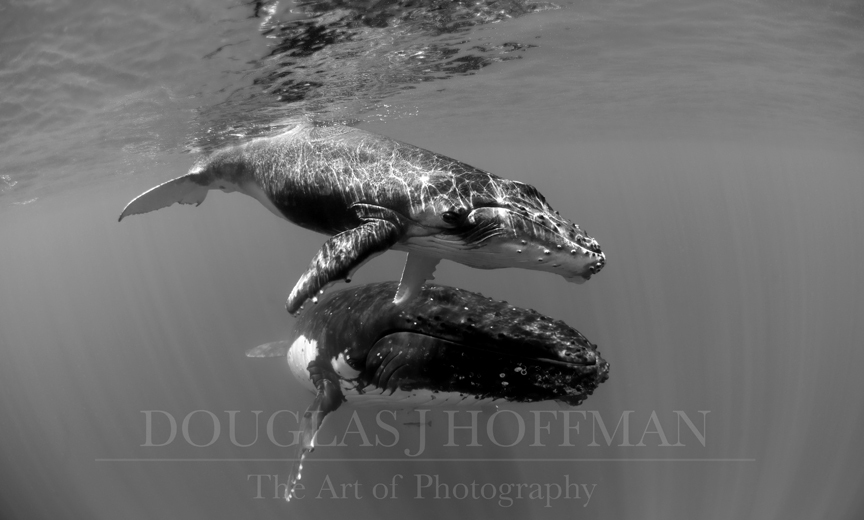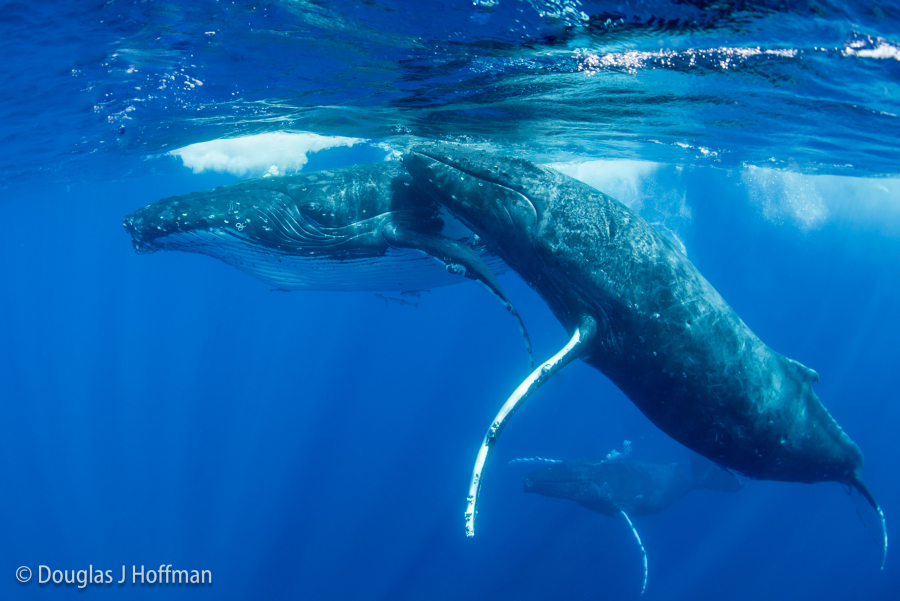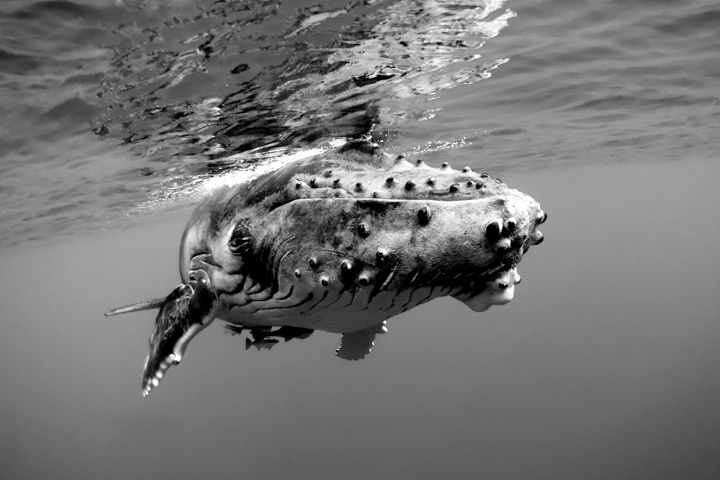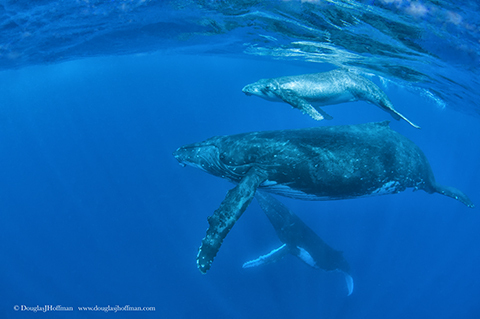Marine Life & Conservation
Swimming with Whales in Tonga

Tonga used to be one of the best kept secrets in adventure travel but those days are numbered. The increase in tourism is to a large part related to whale swimming, but not completely. Tonga has good scuba diving, and is famous for sailing and fishing. In the future look for operators there to start blue water adventure tours in January and February that go out looking for bait balls, pods of dolphins, Pilot Whales, Sperm Whales, Oceanic White Tip Sharks, and Sail fish. This could become a new niche industry.
Tonga is an island nation located in the South Pacific, just three hours flight from New Zealand, or an hour and a half from Fiji. An independent kingdom, Tonga has three island groups, and is comprised of 176 coral and volcanic islands, thirty-six of which are inhabited. Nuku’alofa, the capital, is located on the main island of Tongatapu, while the outer islands are more for tourism.
The Ha’apai group is the middle group and contains numerous flat & low lying islands. When the weather is good, this location is wonderful as it is pristine and there are no crowds. When the weather is bad, there is no place to hide and it can get nasty.
The Vavau’ island group lies to the north and features tall hills, volcanoes, jungle, sandy beaches, and plenty of safe anchorages for boats. For this reason, the majority of visitors go to Vavau’. There are a variety of accommodation levels and standards making it a destination with options for those who travel first class as well as economy. There are several restaurants, bars, shops, and an open market that is colorful and fun.
Each year, Southern Hemisphere Humpback Whales leave their feeding grounds in Antarctica and swim to the tropical waters of Tonga to mate and give birth. They like the shallow protected waters between the islands to nurse and the deeper water for mating.
Wisely, the Tongan government see’s the value of Humpback whales in terms of eco-tourism. Income from Charter boat companies, restaurants, hotels, and taxi’s supports local businesses and generates revenue for the government through taxes.
Whales are wild animals and are not dive sites. In an effort to respect the whales’ needs, and keep Tonga as the preferred mating and birthing grounds, guidelines have been established that outline how whale swimming activities are conducted.
For example, there can be no more than 4 swimmers plus a guide in the water at any time. Swimmers must float together with the guide and are prohibited from free diving on mother and calfs. Scuba diving with the whales is not allowed. Whales must be given a 90 minute break between the time one boat finishes and another boat starts putting swimmers in the water.
Fiji Airways and Air New Zealand offer international service to Tonga. In April of 2016, FIji Airways will start offering two direct flights a week from Nadi to Vavau’ Tonga. Contact Fiji Airways for details at www.fijiairways.com.
Currently Real Tonga is the only domestic airline in Tonga (www.realtonga.to). They have small propeller planes that seat 16 and 19 people. There is no overhead storage in these planes. Upon boarding most personal items are taken and stowed. The baggage allowance on the domestic flight is 44 pounds for check in and 8 pounds for carry on. The fee for extra weight is supposed to go up in 2016 to about $3 (US) a pound. Be advised Real Tonga will weigh everything including you! Pack accordingly.
There are several different kinds of behavior being exhibited in Tonga. Singing is one of them. When this happens the male will go down to 40-60 feet, get vertical, and start singing. Songs last about 20 minutes. The pitch or tone may change from male to male but the song remains the same.
Tracking is another behavior and as it suggests it is when the whales don’t settle and continue heading to an unknown destination. Heat runs are when when male whales fight for dominance and the right to mate with the female. Watching the battle that happens underwater is incredible with action going on everywhere. If the female has a calf the bulls may well try to separate it so they can mate. The female does not want this to happen, but nature is cruel as well as beautiful, and sometimes it does.
Calm periods occur when the mother whale is resting and nursing. This behavior is what can often lead into mutual interactions. This is when the whales are as curious about us as we are about them. If swimmers stay together as a group and the female does not feel stressed by our actions, she will relax and become very comfortable with our presence. When this happens humans and whales float along together, and the baby gets to play.
Swimming with whales is unlike any other experience on earth. Besides being surreal it is quite humbling. Literally you’re floating next to a leviathan that could crush you easily but instead is gentle and curious. When a whale looks you directly in the eye there is an instant connection that will change your life.
When an extended encounter develops and you float along side a mother and calf its possible to observe incredible behavior and communication between the whales. With subtle movements of the body & fin position, and vibrations from the almost invisible hairs on the whales tubercles, the mother communicates with the calf to lets it know its boundaries. Tubercles are the bumpy things that look like barnacles on the front of the whale.
When the mother is relaxed she might log, which is to hang out on the surface or start what is called breathing cycles. This is where the mom goes down to 25 feet or so and hovers motionless in the water for approximately 20 minutes. When its time to breathe, she will slowly rise to the surface and pack her lungs. If everything is good, she will then descend back down to about 25 feet and hover. Each time the mother surfaces is referred to as a cycle. When the mother is relaxed the calf is free to explore its world and check out the humans. This is when wonderful encounters take place and life long memories are made.
Types of Whale Watching Charters
There are a three types of boat charters for swimming with whales. The first are liveaboards. As the name suggests you live on the boat. Currently there are two that operate in Tonga. The first is the Naia, operating most of the year in Fiji, but spends about 5-6 weeks in Tonga. This is a luxury trip complete with chocolates on the pillow. The boat takes 16-18 people.
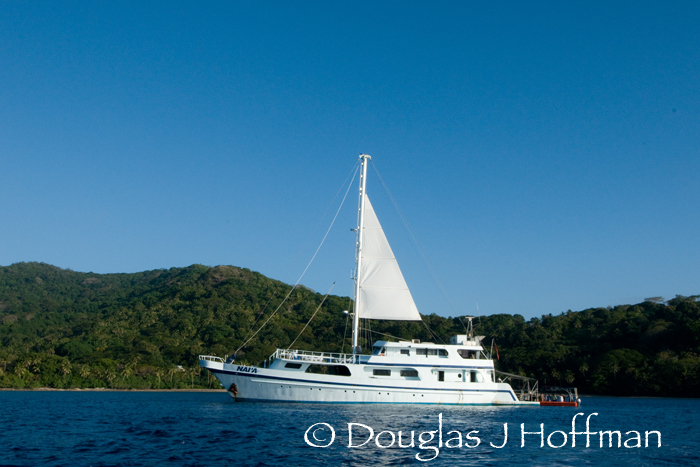
 The other Liveaboard is owned by Whale Discoveries LTD, and is a 53 foot sailing catamaran. This is more of an eco- charter and takes 4-6 guests on a more intimate adventure. Both are good at what they do.
The other Liveaboard is owned by Whale Discoveries LTD, and is a 53 foot sailing catamaran. This is more of an eco- charter and takes 4-6 guests on a more intimate adventure. Both are good at what they do.
The second way to enjoy whale swimming in Tonga is to join a open charter boat. This where the boat takes anywhere from 8-12 people on day trips. Open boats are more affordable and cost an average of $200-250 US per day depending upon the size of boat, number of people taken, whats included, and hours on the water. The majority of boats do 6 hours a day and take between 8-12 people. This is perfect for visitors that want to enjoy a few days whale watching/swimming, as well as a few days of scuba diving, sailing, or exploring the island.
Open charters take anywhere from 8-12 people, and must rotate the swimmers in groups. Each boat is different in how they rotate people in and out of the water. Some do it by time, others by interaction, or breathing cycles.
Those that want to be in the water as much as possible are better suited for a private charter. In this style of charter there are fewer people and less rotations. With fewer people on the boat the price will be significantly higher. But, you get what you pay for.
Most often Private charters are organized by marine naturalists & underwater photographers that understand whale behavior and have years of experience. This insight and knowledge adds to the overall quality of the charter. Rather than try to swim with every whale these professionals will look for specific behaviors that might lead to extended interactions. In comparison, a captain of an open boat might put swimmers in the water with whales he knows are on the move just to be sure all of the rotations of people on the boat get at least a glimpse of whales in the water. While the people will see whales, the quality of experience will be very different.
When it is time to swim, it is very important to be as quiet as possible when entering the water. Whales do not like a lot of noise coming from the surface and their reaction to it is to simply disappear. As each boat is configured differently the crew will explain entry techniques that enable participants to get into the water creating as little noise as possible.
Big fin kicks that break the surface and create a bubble wake are loud and end encounters. Depending upon style of fin used it might be wise to swim side-ways in order to keep them underwater. Large fins made popular by skin divers are not needed as they are designed for ascending and descending, not for horizontal swimming at the surface. Open heel fins are great for scuba diving, but not good for whale swimming. Booties are buoyant and tend to keep the feet toward the surface, which is not good for whale swimming. Full foot fins are best.
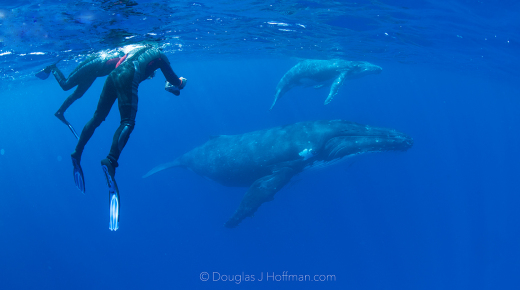 When in the water always stay together in a group and never swim straight towards the whale. Try not to get so lost in the moment that you get between the mother and the calf, as this causes stress for the mother and could quickly end an encounter. If you do get separated from the group just float and give the boat a signal that you’re OK, but to pick you up. Never freedive on the whales.
When in the water always stay together in a group and never swim straight towards the whale. Try not to get so lost in the moment that you get between the mother and the calf, as this causes stress for the mother and could quickly end an encounter. If you do get separated from the group just float and give the boat a signal that you’re OK, but to pick you up. Never freedive on the whales.
Whale Photography Tips
When photographing large animals in the blue, strobes are not used. They create drag and are not powerful enough to light up a whale. So the best thing to do is work with Ambient light. When possible keep the sun behind you and allow it to illuminate the subject. Using a fast shutter speed helps prevent problems like image blur and freezes rays of sunlight bending in the water column. This adds a sense of drama and dimension to the scene. A shutter speed of 1/250th is highly suggested. On days when the sky is dark and overcast turn up the ISO from 100 or 200 to 400 or 800. Set the focus to single, and the drive to continuous low. Shoot short bursts at a time and try to avoid filling the cache.
As or camera mode, select shutter priority. This lets the camera select the f-stop. In blue water work there is not a big issue with depth of field so let the camera do what it wants, as long as it freezes the motion. That said, whales are big and if the camera selects an F-stop of 2.8 -3.5 part of the whale may not be crisp.
Lens Selection
When it comes to whales the wider the lens the better. For those that have cropped sensor DSLR cameras the Tokina 10 -17 mm fisheye and fixed 10.5 mm fish eye are the most popular. Full frame DSLR users can use the Sigma 15 mm, Tokina 10-17, (at 16 or 17 mm), 16 mm fish eye, 16-35 mm, 14-24mm lens, 17-35 and other lenses, or 20 mm. There are a lot of choices; just remember when swimming with whales the smaller the port and camera configuration the easier it is to travel and swim with at the surface.
Trip Insurance
Everyone planning a vacation to Tonga anticipates having a great time. Sometimes however life circumstances beyond your control arise and things change. Boats break, storms arise, people get injured, have accidents, or get sick. For these and other reasons it makes sense that everyone traveling to Tonga should have travel insurance.
DAN, or Divers Alert Network is fantastic. They provide cover for evacuation, and medical expenses due to diving and snorkeling accidents. Their coverage is not comprehensive in terms of medical coverage, nor does it cover trip cancellation, so additional trip insurance is suggested.
I hope you have found this guide helpful. If interested in going on a Private Whale Swim Adventure with me, check out www.douglasjhoffman.com for details or send an email to me at douglas@mauiphotography.net.
Marine Life & Conservation
Paul Watson Released as Denmark Blocks Japan’s Extradition Bid

Renowned anti-whaling activist Paul Watson has been released from custody in Greenland after spending five months in detention. Denmark’s Justice Ministry rejected Japan’s request for his extradition, citing insufficient guarantees that his time already served in custody would be credited against any potential sentence.
The 74-year-old Canadian-American was arrested on July 21 in Nuuk, Greenland’s capital, when his ship docked to refuel. His arrest was based on a 2012 Japanese warrant related to a 2010 encounter in Antarctic waters. Japan alleged Watson obstructed operations and caused damage to a whaling research ship during efforts to disrupt illegal whaling. Watson has consistently denied these claims, maintaining his commitment to marine conservation.
Denmark, which oversees extradition matters for Greenland, concluded that while the legal conditions for extradition were met, the lack of assurances from Japan regarding time-served credit made extradition untenable.
In a video shared by his foundation, Watson expressed gratitude and relief, saying, “After five months, it’s good to be out… and good to know they’re not sending me to Japan.” He added that the most difficult part of his time in custody was being separated from his two young sons.
Watson is a pioneering figure in marine conservation, known for founding the Captain Paul Watson Foundation in 2022 after decades of activism with the Sea Shepherd Conservation Society. His bold efforts to defend marine life have earned him widespread support, including from celebrities and conservationists. His work has also been featured in the acclaimed reality TV series Whale Wars.
Watson’s lawyer, Jonas Christoffersen, praised the decision, stating, “We are happy and relieved that Paul Watson is now free.” He added that Watson is eager to reunite with his family and continue his vital work.
The arrest occurred while Watson’s vessel, the M/Y John Paul DeJoria, was en route to the North Pacific with a team of 26 volunteers to intercept a Japanese whaling ship. His foundation described the arrest as politically motivated and emphasized that Watson’s actions were focused on ending illegal whaling practices.
Japan resumed commercial whaling in 2019 after leaving the International Whaling Commission, asserting that whale meat is a cultural tradition. Conservationists, however, continue to challenge these practices, highlighting their impact on marine ecosystems.
Despite the challenges, Watson remains steadfast in his mission to protect marine life and bring attention to whaling practices. His dedication to ocean conservation has made him a globally respected advocate for the environment.
Marine Life & Conservation
12 Days of Zero-Waste Fish-mas

This holiday period, the Marine Conservation Society, the UK’s leading ocean membership charity, invites you to make some simple changes to eating fish this Christmas to help our seas.
Dr Kenneth Bodles, Head of Fisheries and Aquaculture at the Marine Conservation Society, said, “During the festive season, our consumption increases, but so does waste. Sustainability isn’t just about where food comes from – it’s also about how you use it. By reducing waste and making the most out of your seafood, you’re not only taking steps to be more ocean-friendly, but can also help to cut costs during what is often one of the most expensive times of the year”.
The Marine Conservation Society has compiled twelve tips on how to consume seafood sustainably with zero-waste this Christmas:
Buy whole fish instead of fillets
Instead of fillets, consider buying whole fish such as salmon, hake, or lemon sole. By adopting a “nose to tail” approach with cooking, whole-baked fish not only feeds a crowd, but also helps to minimise waste and maximise sustainability by using up every part of the animal, including bones, skin, and fat.
Make fish stock
Leftover fish bones or shells can be put to good use by boiling them to make a nourishing fish stock or bisque. This can be frozen and preserved for later use and makes for a flavourful base in a soup.
Make your own fish pâté
Avoid waste by turning leftover fish, such as smoked mackerel or salmon, into a delicious pâté by blending with cream cheese and lemon. Perfect when paired with crackers.
The sustainability of salmon and mackerel varies depending on where and how it is caught or farmed. For more information on green-rated options, check the charity’s Good Fish Guide.
Buy frozen
By purchasing seafood that is frozen or vacuum-packed, this helps to reduce waste by extending the shelf life of your food.
Fish pie
If you’re wondering what to do with leftover cooked fish, why not opt for a classic fish pie with mashed potatoes, leeks, and a cheesy sauce? A sure crowd pleaser on Boxing Day.
Use the head
Don’t forget the fish head! The meat is incredibly tender and flavourful. The charity recommends a cod’s head curry or recreating Fallow’s renowned cod’s head in siracha butter.
By stretching your ingredients further, not only is this a more sustainable way to enjoy seafood, but also cost-effective by repurposing leftovers and cooking creatively.
Boxing Day brunch
Mix leftover kippers or smoked salmon with scrambled eggs for a tasty, zero-waste, Boxing Day brunch.
For best choice, make sure you buy kippers, or herring, from the North Sea and the North Irish Sea.
Zero-waste storage
A top tip from the Marine Conservation Society to avoid waste is freezing fish offcuts to save for future use.
Crisp up the skin
Even leftover fish skin can be turned into a quick savoury snack by crisping it up in an air fryer with a little olive oil and salt.
Anchovies two ways
Leftover anchovies can either be blended with butter to make a delicious anchovy butter or tossed into pasta for a hit of umami flavour.
The charity recommends opting for anchovies caught in the Bay of Biscay for best choice.
Fishcakes
For an easy, zero-waste meal, leftover seafood trimmings can be mixed with mash and fried in breadcrumbs to make fishcakes.
Pickled mussels
Try pickling mussels in 1:1 vinegar and water, with a dash of sugar for a sustainable, zero-waste snack that can be enjoyed well beyond the festive season.
Mussels farmed in the UK are a seafood superhero. Grown using low-impact methods and harvested by hand, they get all the food they need from the sea around them. This makes them one of the most sustainable, ocean-friendly, and cost-effective seafood options.
Players of People’s Postcode Lottery have raised £6.6M towards the Marine Conservation Society’s vital work in making seafood more sustainable.
Laura Chow, Head of Charities at People’s Postcode Lottery, said: “Fish is a festive favourite for many, but making sustainable choices when it comes to how we buy and eat seafood makes all the difference for our ocean. Support from players of People’s Postcode Lottery has helped the Marine Conservation Society further its sustainable seafood work, so that we can all enjoy healthier, better protected seas.”
The Marine Conservation Society encourages you to make sustainable seafood choices a year-round habit, not just for Christmas. To check how sustainable the seafood on your plate is, you can visit the charity’s Good Fish Guide. The Guide helps consumers and businesses identify the most sustainable seafood using a simple traffic light system, based on where and how species are caught or farmed. Green is the best choice, amber means improvements are needed, and red indicates fish to avoid buying.
Zero-waste gift idea
Why not embrace a zero-waste Christmas by gifting a membership to support marine conservation? It’s a meaningful, low-waste gift that helps protect our ocean for generations to come. Memberships start from as little as £5 a month – the price of a sandwich and drink from your local coffee shop.
Find the latest sustainable seafood advice for wild-caught and farmed seafood on the Good Fish Guide, downloadable to your phone from www.mcsuk.org/goodfishguide.
-

 News2 months ago
News2 months agoIconic SS United States to become the World’s Largest Artificial Reef
-

 News3 months ago
News3 months agoBook Review – 52 Assignments: Underwater Photography
-

 Gear News3 months ago
Gear News3 months agoDYNAMICNORD – New German diving brand enters the British market
-

 News3 months ago
News3 months agoExploring Cenote El Pit: A Diver’s Dream
-

 Gear News3 months ago
Gear News3 months agoTry BARE drysuits (and maybe even win one!) this Friday with Sea & Sea at North West Dive Fest
-

 Marine Life & Conservation3 months ago
Marine Life & Conservation3 months agoBook Review: Coral Triangle Cameos
-

 Blogs2 months ago
Blogs2 months agoDive the Egyptian Red Sea this Autumn with Regaldive
-

 News3 months ago
News3 months ago2024 Ocean Art Underwater Photo Competition Announced




